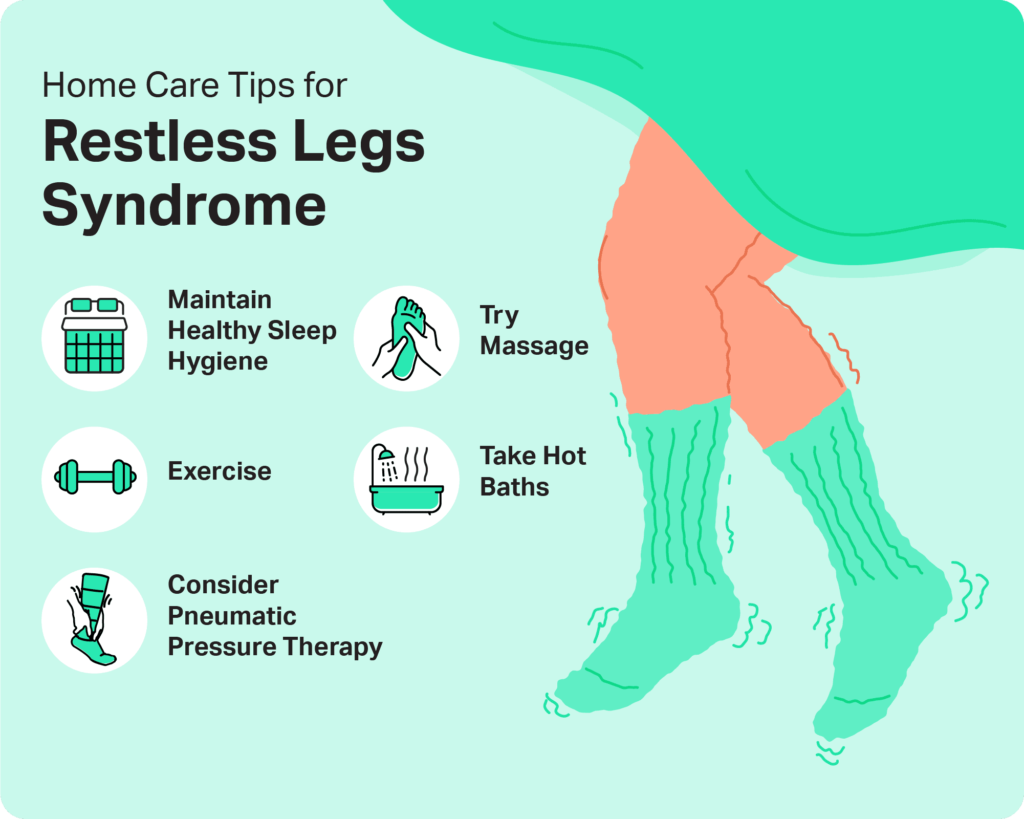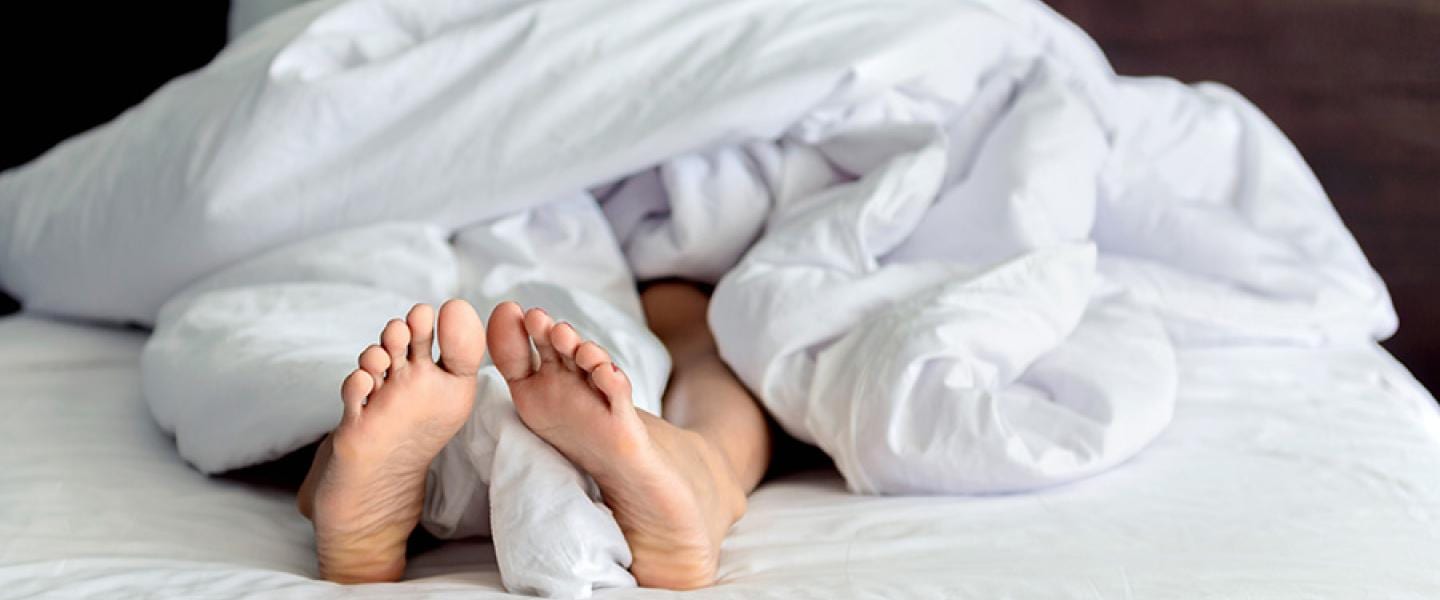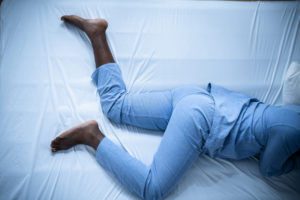Treatment for Restless Legs Syndrome
- Medications: The most common medications for restless leg syndrome include anti-seizure medications and iron supplementation for those with low levels.
- Medical Devices: Wearable devices that stimulate the muscles can prevent RLS symptoms without disrupting sleep.
- Home Remedies: At-home restless leg syndrome treatment can include symptom-relieving warm baths, massage, stretching, and walking.
When you have restless legs syndrome (RLS), you feel an uncontrollable urge to move your legs and sometimes arms, a sensation that can wake you throughout the night. Although this sleep-related movement disorder has no cure, there are treatment options available that can help manage the discomfort and reduce sleep disruptions.
Treatment for restless legs syndrome often depends on whether there are underlying conditions contributing to your symptoms. While the exact cause of RLS isn’t fully understood, experts believe it may be linked to factors such as stress, low iron or vitamin D levels, and imbalances in brain chemicals like GABA. Based on these possibilities, your doctor will tailor a treatment plan that targets the most likely cause.
Is Your Troubled Sleep a Health Risk?
A variety of issues can cause problems sleeping. Answer three questions to understand if it’s a concern you should worry about.
Addressing the Underlying Cause
Since RLS can occur on its own or as a result of another medical condition, treatment for RLS symptoms may need to be approached differently depending on the root cause. Before proceeding with RLS treatment, experts recommend looking for other conditions that could be causing or aggravating RLS symptoms . Common culprits include:
- Sleep deprivation
- Stress
- A sedentary lifestyle
- Obesity
- Alcohol, nicotine, and caffeine use
- Pregnancy
- Diabetes
- Sleep-disordered breathing
- Peripheral neuropathy
- Renal insufficiency
- Medication such as antihistamines and certain antidepressants
For many people, addressing these factors may lead to a drastic reduction in RLS symptoms. However, if symptoms are still bothersome, or if they interfere with sleep, doctors may advise additional treatments.
Restless Legs Syndrome Medication
Your doctor can suggest medications as treatment for restless leg syndrome based on your symptoms and medical history.
Anti-Seizure Drugs
Anti-seizure medications like gabapentin (Neurontin) and pregabalin (Lyrica) affect how your brain releases neurotransmitters, which can improve RLS symptoms. The U.S. Food and Drug Administration (FDA) has approved a version of gabapentin for RLS called Horizant, which is taken early every evening.
If high doses of gabapentin don’t reduce symptoms enough, providers will sometimes try pregabalin, which works similarly but can be absorbed in higher doses. Research shows these medications stay effective for one to five years, after which other treatment options can help.
In 2019, the FDA released a warning that gabapentin and pregabalin may cause breathing problems in people who also take opioid medications or have COPD, but your doctor can help you assess your risk.
Dopamine Agonists
Before 2012, dopamine agonists like pramipexole and ropinirole were considered a standard treatment for restless leg syndrome, but now the American Academy of Sleep Medicine (AASM) discourages their use.
Researchers have discovered this drug class may lessen RLS symptoms at first, but over time, it can cause serious side effects like excessive daytime sleepiness, “sleep attacks,” impulse-control problems, and addictive behaviors. It can also require higher and higher doses over time, and may end up worsening RLS symptoms. This phenomenon is called “augmentation.”
Benzodiazepines
Benzodiazepines can treat anxiety, insomnia, and muscle spasms, and providers have historically prescribed them for RLS for their relaxing and sleep-inducing effects. But we now know these medications can cause severe dependence, side effects, and withdrawal symptoms, so the AASM no longer recommends them for RLS.
Opioids
For severe cases of restless legs syndrome that don’t resolve with other treatments, some providers may prescribe an opioid medication like tramadol, oxycodone, or methadone.
Opioids work well for short-term management of discomfort associated with RLS, but can cause side effects like excessive drowsiness, constipation, and dependence. If opioids are needed, the AASM recommends using extended-release oxycodone, but your doctor will provide options with your health history in mind.
Supplements for Restless Legs Syndrome
Mineral levels in the bloodstream may play a role in RLS. For example, studies show people with RLS often have higher levels of zinc and lower levels of iron and vitamin D than those without the disorder. Because of this, researchers have studied the potential therapeutic effects of taking dietary supplements for symptom relief.
Iron
Iron is the most studied and recommended supplement for restless legs syndrome, and the AASM recommends iron replacement as a first-line therapy for anyone with low levels. The ideal iron levels when treating RLS are usually on the high side of normal. If iron tablets aren’t tolerated well or don’t raise iron levels enough, you can also get iron infusions through an IV.
Vitamin D
Since vitamin D may be connected to RLS, some experts recommend supplementing this nutrient for those with low levels. Current studies haven’t shown enough evidence to recommend vitamin D for RLS officially, but the AASM suggests this treatment option is worth additional research.
Magnesium
Magnesium is often recommended for leg cramps at night, and some research suggests it can also relieve RLS symptoms. Some studies have shown low magnesium levels correlate with worse RLS severity, and others show taking magnesium lessens discomfort. Some studies, though, found no difference between those who took magnesium and those who didn’t, and more research is needed to prove its effectiveness. However, magnesium supplementation can help with general sleep quality.

Medical Devices
Some medical devices may treat restless leg syndrome by recreating the muscle movement that naturally provides relief from unpleasant RLS sensations.
Peroneal Nerve Stimulation
The peroneal nerve runs along the back of the thigh until it gets to the knee, where it curves around, splits off into two, and continues all the way down to the toes. When you have RLS, this nerve can fail to stop signals from the spine that prompt involuntary leg movement.
Because of this connection, some devices aim to stimulate the peroneal nerve to tighten your muscles enough to lessen RLS symptoms but not disturb your sleep. The FDA recently approved a tonic motor activation (TOMAC) device for this purpose. To use it, you wear soft bands around the calf below each knee, and the device activates your muscles throughout the night. Research shows these devices are safe and well-tolerated by most people.
Compression Foot Wrap
Another medical device option, a compression foot wrap, may also improve RLS severity, but has less research to back it up. In 2013, the FDA approved a compression wrap called Restiffic, which was designed to apply pressure to muscles in the feet for RLS symptom improvement.
Vibrating Pad
Vibrating pads apply counter-stimulation to the skin to lessen RLS symptoms, and some studies show using one for just 30 minutes can improve sleep quality. One large study review confirmed these findings, reporting vibration therapy reduced RLS symptoms dramatically.
Home Remedies
Alongside other treatments, you can try home remedies for restless legs syndrome. Research shows these therapies may provide relief:
- Massage
- Warm baths
- Stretching
- Walking
- Distraction
- Acupressure
- Aromatherapy
- Compression stockings
While studies don’t tell us a lot about how well these techniques work, they also come with very little risk, and so providers may recommend trying them.

Lifestyle Changes
Another way to keep restless legs syndrome at bay is to follow healthy lifestyle practices that encourage neurological health. The National Institutes of Health recommends the following habits to help reduce RLS severity.
Get Good Sleep
Try to sleep seven to eight hours each night, which may improve RLS symptoms. You can get your best sleep by following proper sleep hygiene: Go to bed and wake up at the same time each day, follow a calming bedtime routine, and make your sleep space cool, dark, quiet, and comfortable.
Exercise Regularly
Some small trials show exercise may also help improve RLS symptoms, but no recent research has confirmed this. However, regular exercise can improve sleep and many other body functions, and experts recommend trying for at least 150 minutes of moderate-intensity activity (or 75 of vigorous activity) each week, plus two days of muscle-strengthening activities.
Avoid Dietary Triggers
Alcohol, caffeine, and nicotine can make RLS symptoms worse, so it’s best to avoid them, especially close to bedtime. Although alcohol can relax you, its overuse can actually dysregulate how your muscles relax and contract. In addition to relieving RLS symptoms, a healthy diet can help improve sleep quality.
Treat Obstructive Sleep Apnea
Untreated obstructive sleep apnea and restless leg syndrome are distinct sleep disorders, however they can worsen each other’s symptoms. Sleep apnea can cause fragmented sleep which amplifies RLS when sleep is disturbed. Untreated sleep apnea, especially if severe, can cause chronically low oxygen levels, inflammation, and changes in brain chemical balances, all of which may increase RLS symptoms.
Ask About Your Medications
For some, antihistamines can worsen RLS symptoms, although experts don’t fully understand why. Some animal studies suggest they may affect part of the brain that controls your motor function, especially in RLS caused by low iron.
Antipsychotic medications are also a known culprit in increased RLS symptoms. These medications change how certain neurotransmitters function in order to treat mental health disorders, which can cause restless leg symptoms as a side effect. If you take either of these medications regularly, you can ask your doctor if they (or any other medications) could be contributing to the problem.
Lifestyle changes like those above can help and are generally safe for anyone with RLS. But be sure to discuss your treatment plan as a whole with your doctor for the most benefit.
Frequently Asked Questions
Does drinking lots of water help restless legs?
Although no current research supports drinking water for restless leg syndrome relief, good hydration is vital for overall health.
What is the best position to sleep in with restless legs syndrome?
No recent studies show one position works best for RLS symptoms, but through trial and error, you may find some positions keep you more comfortable than others.
What makes restless legs syndrome worse at night?
Restless legs syndrome may be worse at night because dopamine levels naturally fall in response to your circadian rhythm (internal clock), which may affect RLS symptoms.

Still have questions? Ask our community!
Join our Sleep Care Community — a trusted hub of sleep health professionals, product specialists, and people just like you. Whether you need expert sleep advice for your insomnia or you’re searching for the perfect mattress, we’ve got you covered. Get personalized guidance from the experts who know sleep best.
References
29 Sources
-
National Institute of Neurological Disorders and Stroke. (2023, February 7). Restless legs syndrome.
https://www.ninds.nih.gov/health-information/disorders/restless-legs-syndrome -
Schwab, R. J. (2022, September). Periodic limb movement disorder (PLMD) and restless legs syndrome (RLS). Merck Manual Consumer Version.
https://www.merckmanuals.com/home/brain,-spinal-cord,-and-nerve-disorders/sleep-disorders/periodic-limb-movement-disorder-plmd-and-restless-legs-syndrome-rls -
Jiménez-Jiménez, F. J., Alonso-Navarro, H., García-Martín, E., & Agúndez, J. (2019). Neurochemical features of idiopathic restless legs syndrome. Sleep Medicine Reviews, 45, 70–87.
https://pubmed.ncbi.nlm.nih.gov/30965199/ -
Gossard, T. R., Trotti, L. M., Videnovic, A., & St Louis, E. K. (2021). Restless Legs Syndrome: Contemporary Diagnosis and Treatment. Neurotherapeutics : the journal of the American Society for Experimental NeuroTherapeutics, 18(1), 140–155.
https://pubmed.ncbi.nlm.nih.gov/33880737/ -
Garcia-Borreguero, D., Silber, M. H., Winkelman, J. W., Högl, B., Bainbridge, J., Buchfuhrer, M., Hadjigeorgiou, G., Inoue, Y., Manconi, M., Oertel, W., Ondo, W., Winkelmann, J., & Allen, R. P. (2016). Guidelines for the first-line treatment of restless legs syndrome/Willis-Ekbom disease, prevention and treatment of dopaminergic augmentation: a combined task force of the IRLSSG, EURLSSG, and the RLS-foundation. Sleep Medicine, 21, 1–11.
https://pubmed.ncbi.nlm.nih.gov/27448465/ -
Winkelman, JW, Berkowski, JA, DelRosso, et al. Treatment of restless legs syndrome and periodic limb movement disorder: an American Academy of Sleep Medicine clinical practice guideline. J Clin Sleep Med. 2025;21(1):137–152
https://jcsm.aasm.org/doi/10.5664/jcsm.11390 -
Bugnicourt, JM. Dopamine Agonists in the Treatment of Restless Legs Syndrome: Too Much of a Good Thing? J Sleep Med. 2024;21(1)
https://www.e-jsm.org/journal/view.php?doi=10.13078/jsm.230030 -
Vlasie, A., Trifu, S. C., Lupuleac, C., Kohn, B., & Cristea, M. B. (2022). Restless legs syndrome: An overview of pathophysiology, comorbidities and therapeutic approaches (Review). Experimental and therapeutic medicine, 23(2), 185
https://pubmed.ncbi.nlm.nih.gov/35069866/ -
Edinoff, A. N., Nix, C. A., Hollier, J., Sagrera, C. E., Delacroix, B. M., Abubakar, T., Cornett, E. M., Kaye, A. M., & Kaye, A. D. (2021). Benzodiazepines: Uses, Dangers, and Clinical Considerations. Neurology international, 13(4), 594–607.
https://pubmed.ncbi.nlm.nih.gov/34842811/ -
Cite Jiménez-Jiménez, F. J., Ayuso, P., Alonso-Navarro, H., Calleja, M., Díez-Fairén, M., Álvarez, I., Pastor, P., Plaza-Nieto, J. F., Navarro-Muñoz, S., Turpín-Fenoll, L., Millán-Pascual, J., Recio-Bermejo, M., García-Ruiz, R., García-Albea, E., Agúndez, J. A. G., & García-Martín, E. (2022). Serum Trace Elements Concentrations in Patients with Restless Legs Syndrome. Antioxidants (Basel, Switzerland), 11(2), 272
https://pubmed.ncbi.nlm.nih.gov/35204155/ -
Cederberg KLJ, Silvestri R, Walters AS. Vitamin D and Restless Legs Syndrome: A Review of Current Literature. Tremor Other Hyperkinet Mov (N Y). 2023 Apr 6;13:12
https://pmc.ncbi.nlm.nih.gov/articles/PMC10077981/ -
Liu, Zhao MMa,*; Guan, Ruiqian MMa,b; Pan, Limin MDa,c. Exploration of restless legs syndrome under the new concept: A review. Medicine. 2022 Dec 16; 101(50):p e32324
https://journals.lww.com/md-journal/fulltext/2022/12160/exploration_of_restless_legs_syndrome_under_the.45.aspx -
González-Parejo, P., Martín-Núñez, J., Cabrera-Martos, I., & Valenza, M. C. (2024). Effects of Dietary Supplementation in Patients with Restless Legs Syndrome: A Systematic Review. Nutrients, 16(14), 2315.
https://pubmed.ncbi.nlm.nih.gov/39064758/ -
Gorantla, S., Ravisankar, A., & Trotti, L. M. (2024). Magnesium citrate monotherapy improves restless legs syndrome symptoms and multiple suggested immobilization test scores in an open-label pilot study. Journal of clinical sleep medicine : JCSM : official publication of the American Academy of Sleep Medicine, 20(8), 1357–1361.
https://pubmed.ncbi.nlm.nih.gov/38738598/ -
Charlesworth, J. D., Adlou, B., Singh, H., & Buchfuhrer, M. J. (2023). Bilateral high-frequency noninvasive peroneal nerve stimulation evokes tonic leg muscle activation for sleep-compatible reduction of restless legs syndrome symptoms. Journal of clinical sleep medicine : JCSM : official publication of the American Academy of Sleep Medicine, 19(7), 1199–1209.
https://pubmed.ncbi.nlm.nih.gov/36856064/ -
Türkoglu, Ş. A., Bolac, E. S., Yildiz, S., Kalaycioglu, O., & Yildiz, N. (2021). Presynaptic inhibition in restless legs syndrome. The International journal of neuroscience, 131(3), 213–219.
https://pubmed.ncbi.nlm.nih.gov/32108535/ -
Bogan, R. K., Roy, A., Kram, J., Ojile, J., Rosenberg, R., Hudson, J. D., Scheuller, H. S., Winkelman, J. W., & Charlesworth, J. D. (2023). Efficacy and safety of tonic motor activation (TOMAC) for medication-refractory restless legs syndrome: a randomized clinical trial. Sleep, 46(10), zsad190.
https://pubmed.ncbi.nlm.nih.gov/37458698/ -
Sullivan, J, Olson, D. RESTIFFIC, a unique pressure foot wrap, is more effective than a dopamine agonist in reducing the symptoms of moderate to severe Restless Leg Syndrome. Neurology. 2015, April 6; 84 (14_supplement)
https://www.neurology.org/doi/10.1212/WNL.84.14_supplement.P7.296 -
Buchfuhrer MJ, Baker FC, Singh H, Kolotovska V, Adlou B, Anand H, de Zambotti M, Ismail M, Raghunathan S, Charlesworth JD. Noninvasive neuromodulation reduces symptoms of restless legs syndrome. J Clin Sleep Med. 2021 Aug 1;17(8):1685-1694.
https://pmc.ncbi.nlm.nih.gov/articles/PMC8656897/ -
Ratnani, G., & Harjpal, P. (2023). Advancements in Restless Leg Syndrome Management: A Review of Physiotherapeutic Modalities and Their Efficacy. Cureus, 15(10), e46779.
https://pubmed.ncbi.nlm.nih.gov/37954781/ -
Kubasch, J., Ortiz, M., Binting, S., Roll, S., Icke, K., Dietzel, J., Nögel, R., Hummelsberger, J., Willich, S. N., Brinkhaus, B., Teut, M., & Siewert, J. (2025). Hydrotherapy and acupressure in restless legs syndrome: results of a randomized, controlled, three-armed, pilot study (HYDRAC-study). Frontiers in medicine, 12, 1571045.
https://pubmed.ncbi.nlm.nih.gov/40309736/ -
National Heart, Lung, and Blood Institute. (2022 March 4). Sleep deprivation and deficiency.
https://www.nhlbi.nih.gov/health/sleep-deprivation/healthy-sleep-habits -
U.S. Department of Health and Human Services. (n.d.). Physical activity guidelines for Americans (2nd edition).
https://health.gov/sites/default/files/2019-09/Physical_Activity_Guidelines_2nd_edition.pdf -
Alleyne J, Dopico AM. Alcohol Use Disorders and Their Harmful Effects on the Contractility of Skeletal, Cardiac and Smooth Muscles. Adv Drug Alcohol Res. 2021 Oct;1:10011.
https://pmc.ncbi.nlm.nih.gov/articles/PMC8843239/ -
Lai, Y. Y., Hsieh, K. C., Cheng, Y. H., Chew, K. T., Nguyen, D., Ramanathan, L., & Siegel, J. M. (2020). Striatal histamine mechanism in the pathogenesis of restless legs syndrome. Sleep, 43(2), zsz223.
https://pubmed.ncbi.nlm.nih.gov/31671173/ -
Saber, W. K., Almuallim, A. R., & Algahtani, R. (2022). Restless Legs Syndrome and the Use of Antipsychotic Medication: An Updated Literature Review. Cureus, 14(8), e27821.
https://pubmed.ncbi.nlm.nih.gov/36134065/ -
U.S. Centers for Disease Control and Prevention. (2022, June 6). Water and Healthier Drinks.
https://www.cdc.gov/healthy-weight-growth/water-healthy-drinks/index.html -
Zhang Y, Xiao A, Zheng T, Xiao H, Huang R. The Relationship between Sleeping Position and Sleep Quality: A Flexible Sensor-Based Study. Sensors (Basel). 2022 Aug 19;22(16):6220.
https://pmc.ncbi.nlm.nih.gov/articles/PMC9416198/




